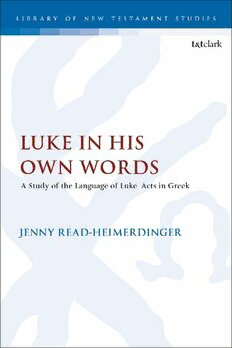
Luke in His Own Words: A Study of the Language of Luke–Acts in Greek PDF
265 Pages·2022·2.265 MB·
Most books are stored in the elastic cloud where traffic is expensive. For this reason, we have a limit on daily download.
Preview Luke in His Own Words: A Study of the Language of Luke–Acts in Greek
Description:
Jenny Read-Heimerdinger examines the language of Luke–Acts, exploring aspects of Luke’s use of Greek that traditional approaches have not generally accounted for previously. Drawing on contemporary developments in linguistics – broadly referred to as ‘discourse analysis’ – Read-Heimerdinger emphasises that paying close attention to the context of language is vital to understanding the reasons behind an author’s choices.Read-Heimerdinger applies the tools of discourse analysis to several features of Luke’s Greek – such as variation in word order, the use of the article and fine distinctions between synonyms – in order to demonstrate how principles that govern their use subsequently affect exegesis. In addition, she makes suggestions to account for manuscript variation, which in turn have an impact on the editorial choices of Nestle-Aland’s Greek New Testament.The work gathers together articles on linguistic features of Luke’s writings that I have previously published in various places. The aim is to establish patterns of language that Luke uses, specifically among aspects that are subject to recurring variation among the manuscripts. Each chapter seeks to elucidate the principles behind Luke’s usage and to evaluate variant readings between Codex Vaticanus and Codex Sinaiticus as representatives of the Alexandrian text generally preferred by the current edition of the Greek New Testament, and Codex Bezae as the Greek manuscript that is the most consistently different from the tradition they transmit. A general introduction sets out the background to the articles and explains the rationale behind them, presenting the linguistic and textual tools that are used to analyse the text of Luke’s writing in the two main forms in which it has been handed down. Seven features that recur among the variant readings are selected for examination in separate chapters: the use of the article before proper names of persons and places; the range of sentence connectives and the particular force of each one; the flexibility of word order with a focus on the noun phrase; the range of expressions Luke uses to refer to the Holy Spirit; how he tracks participants with third person pronouns when they are the object of successive verbs; parallel expressions that Luke uses to encode his message, taking the examples of introducing the addressee of direct speech, the naming of participants and the choice between and to make comparisons; how Luke has organised his material in his two books in a cohesive structure. For each feature, the text common to the two textual traditions is examined to determine Luke’s usage; the results are then compared with the variant readings to see how and why the differences might have occurred. Throughout the studies, tools of discourse analysis are applied to establish what is communicated by the flexibility in usage and assess the impact that pragmatic factors might have on the variation. A final chapter draws together the findings, concluding that the variation between the manuscripts corresponds more to different narratorial purposes and perspectives than the result of scribal emendation, with Codex Bezae reflecting what could be considered the intention of an earlier narrator than that of the Alexandrian text.
See more
The list of books you might like
Most books are stored in the elastic cloud where traffic is expensive. For this reason, we have a limit on daily download.
